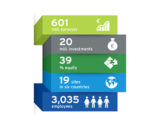
Sappi second quarter beats expectations
May 16, 2018Commenting on the results, Sappi Chief Executive Officer Steve Binnie said “I am very satisfied with our performance for this quarter as reflected by increased sales, EBITDA and net profit. I’m particularly pleased that all regions were able to deliver higher sales volumes despite the short-term impact of the expansion and conversion projects. We faced higher raw material costs, in particular pulp, for our paper businesses but were able to increase selling prices to offset most of this impact. The acquisition of the Cham speciality paper business was completed during the quarter and the integration into Sappi is moving ahead smoothly.”
Turning to the next quarter, Binnie stated “Our operating performance for the third quarter is expected to be in line with that of the prior year as the impact of the stronger Rand and the various capital projects underway will offset the improved paper markets.”
Financial summary for the quarter
EBITDA excluding special items US$211 million (Q2 2017 US$208 million).
Profit for the period US$102 million (Q2 2017 US$88 million).
EPS excluding special items 17 US cents (Q2 2017 17 US cents).
Acquisition of Cham speciality paper business completed.
Net debt US$1,632 million (Q2 2017 US$1,329 million).
The major factors which influenced the second quarter’s results include
Dissolving wood pulp (DWP) demand remained strong with pricing improving steadily during the quarter
Demand for specialities and packaging papers continued to grow across all regions and all major product segments, only constrained by our current production capacity. EBITDA margins improved to 15%
European and export printing and writing papers markets were stable, allowing for the implementation of coated paper price increases that have offset much of the rise in paper pulp costs. In the US, sales volumes increased in all product categories and higher graphic paper prices were achieved
Paper pulp costs continued to rise throughout the quarter, and
A stronger RandUS Dollar exchange rate lowered the profitability of the South African businesses.


